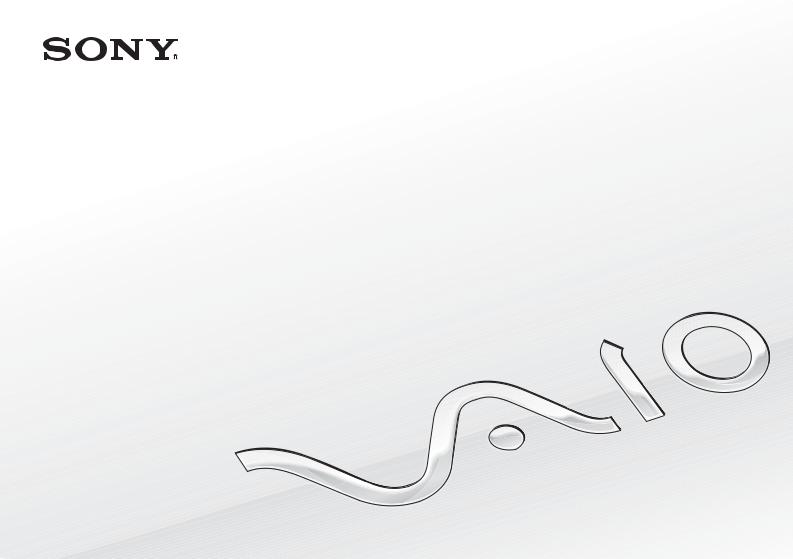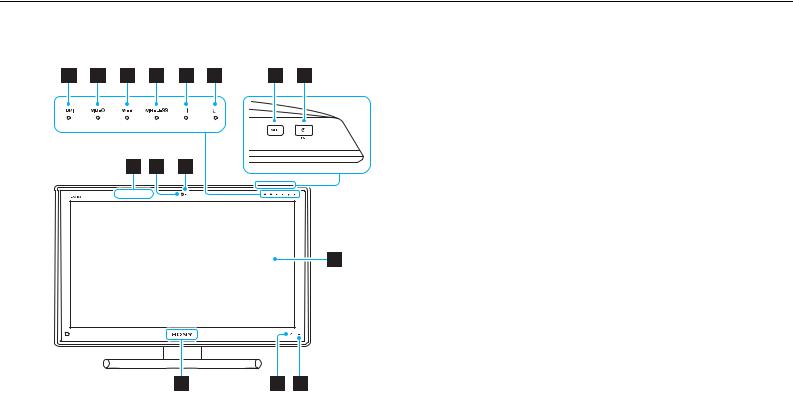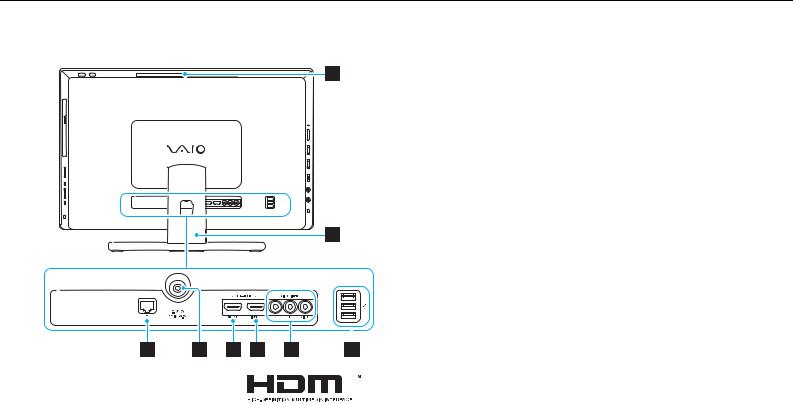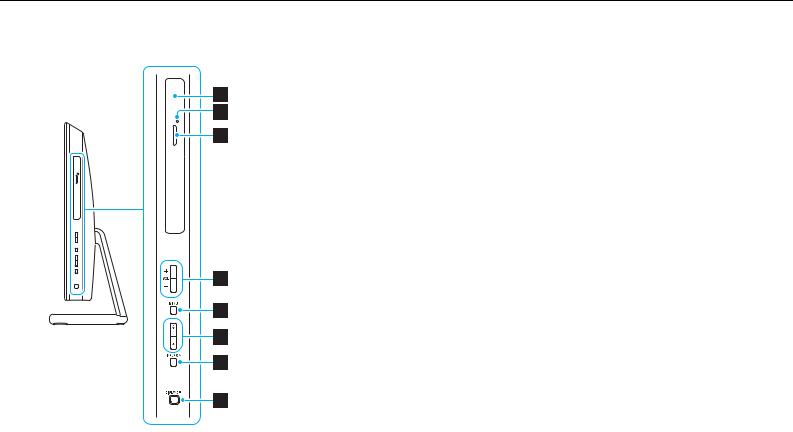Sony VPCL22S1E, VPCL22S1R, VPCL22Z1E, VPCL22V1E, VPCL22Z1R Manual

N
User Guide
Personal Computer
VPCL2 Series

n 2 N
Contents |
|
Before Use.......................................................................... |
4 |
Finding More about Your VAIO Computer .................... |
5 |
Ergonomic Considerations ............................................ |
8 |
Getting Started.................................................................. |
10 |
Locating Controls and Ports........................................ |
11 |
About the Indicator Lights ........................................... |
17 |
Setting Up Your Computer .......................................... |
18 |
Shutting Down Your Computer Safely ........................ |
20 |
Using the Power Saving Mode.................................... |
21 |
Keeping Your Computer in Optimum Condition .......... |
24 |
Using Your VAIO Computer.............................................. |
27 |
Using the Keyboard..................................................... |
28 |
Using the Mouse ......................................................... |
35 |
Using the Touch Screen.............................................. |
40 |
Using the Edge Access ............................................... |
44 |
Using Special-function Buttons ................................... |
45 |
Using the Quick Web Access Function ....................... |
47 |
Using the Built-in Camera ........................................... |
49 |
Using the Optical Disc Drive ....................................... |
50 |
Using the 3D Function................................................. |
58 |
Using the HDMI/VIDEO Input Function....................... |
60 |
Using "Memory Stick".................................................. |
65 |
Using Other Modules / Memory Cards ........................ |
72 |
Using the Internet ........................................................ |
76 |
Using the Network (LAN)............................................. |
77 |
Using the Wireless LAN............................................... |
78 |
Using the BLUETOOTH Function................................ |
83 |
Using Peripheral Devices.................................................. |
88 |
Connecting External Speakers or Headphones .......... |
89 |
Connecting an External Display .................................. |
90 |
Selecting Display Modes ............................................. |
97 |
Using the Multiple Monitors Function .......................... |
98 |
Connecting an External Microphone ......................... |
100 |
Connecting a USB Device ......................................... |
101 |
Connecting an i.LINK Device..................................... |
103 |
Customizing Your VAIO Computer.................................. |
105 |
Setting the Password................................................. |
106 |
Using the VAIO Control Center ................................. |
112 |
Upgrading Your VAIO Computer..................................... |
115 |
Adding and Removing Memory ................................. |
116 |

n 3 N
Precautions..................................................................... |
122 |
Safety Information ..................................................... |
123 |
Care and Maintenance Information........................... |
125 |
Handling Your Computer........................................... |
126 |
Handling the LCD Screen/Touch Screen .................. |
128 |
Using the Power Source ........................................... |
129 |
Handling the Built-in Camera .................................... |
130 |
Handling Discs .......................................................... |
131 |
Handling "Memory Stick"........................................... |
132 |
Handling the Built-in Storage Device ........................ |
133 |
Troubleshooting .............................................................. |
134 |
Computer Operations................................................ |
136 |
System Update / Security.......................................... |
141 |
Recovery / Recovery Media ...................................... |
142 |
Partition ..................................................................... |
143 |
Built-in Camera ......................................................... |
144 |
Networking (LAN/Wireless LAN) ............................... |
146 |
BLUETOOTH Technology......................................... |
150 |
Optical Discs ............................................................. |
153 |
Display ...................................................................... |
158 |
Printing ...................................................................... |
162 |
Microphone ............................................................... |
163 |
Mouse ....................................................................... |
164 |
Speakers ................................................................... |
166 |
Touch Screen ............................................................ |
168 |
Keyboard ................................................................... |
169 |
Floppy Disks .............................................................. |
170 |
Audio/Video ............................................................... |
171 |
HDMI/VIDEO Input Function ..................................... |
174 |
"Memory Stick" .......................................................... |
175 |
Peripherals ................................................................ |
176 |
About the International ENERGY STAR(R) Program...... |
177 |
Trademarks ..................................................................... |
178 |
Notice .............................................................................. |
180 |

Before Use >
n 4 N
Before Use
Congratulations on your purchase of this VAIO® computer and welcome to the on-screen User Guide. Sony has combined leading-edge technology in audio, video, computing, and communications to provide you with a state-of-the-art computing experience.
!
External views illustrated in this manual may look slightly different from those of your computer.
 How to find specifications
How to find specifications
Some features, options, and supplied items may not be available on your computer.
To find out about the configuration of your computer, visit the VAIO Support web site at http://support.vaio.sony.eu/.

Before Use > |
|
Finding More about Your VAIO Computer |
n 5 N |
Finding More about Your VAIO Computer
This section provides support information about your VAIO computer.
1. Printed Documentation
Quick Start Guide — An overview of components connection, set-up information, etc.
Recovery, Backup and Troubleshooting Guide
Enjoying 3D: Information Guide (On selected models only)
Safety Regulations and Support Information
Before activating the wireless functions such as the wireless LAN and BLUETOOTH technology, read the Safety Regulations and Support Information carefully.

Before Use > |
|
Finding More about Your VAIO Computer |
n 6 N |
2. On-screen Documentation
VAIO User Guide — General information of your VAIO computer including support and troubleshooting information. To access VAIO User Guide, click Start  , All Programs, and VAIO Manual.
, All Programs, and VAIO Manual.
Windows Help and Support — A comprehensive resource for practical advice, tutorials, and demonstrations to help you learn to use your computer.
To access Windows Help and Support, click Start and Help and Support, or press and hold the Microsoft Windows key and press the F1 key.

Before Use > |
|
Finding More about Your VAIO Computer |
n 7 N |
3. Support Web Sites
If you experience any problem with your VAIO computer, launch the VAIO Care, which offers you various options to help you solve most problems. For details, see Using the VAIO Care (page 26).
If you need more assistance, visit the VAIO Support web site at http://support.vaio.sony.eu/.
When you contact VAIO Support, you will be asked for the serial number of the computer.
The serial number is a 15-digit number that can be found at the bottom of the VAIO Care window; on the bottom or the back panel of the computer; or inside the battery compartment.
Other sources for information about the VAIO computer are:
The VAIO Forum at http://www.sony.eu/discussions/community/en/support/vaio_and_computing/, which enables you to interact with other VAIO users in VAIO social community.
The VAIO web site at http://www.vaio.eu/, which offers product information
Sony Store, Online at http://www.sony.eu/store

Before Use > |
|
Ergonomic Considerations |
n 8 N |
Ergonomic Considerations
Whenever possible, you should attempt to take account of the following ergonomic considerations:
Position of your computer – Place the display directly in front of you. Keep your forearms horizontal, with your wrists in a neutral, comfortable position while using the keyboard or the pointing device. Let your upper arms hang naturally at your sides. Take frequent breaks while using your computer. Excessive use of the computer may strain eyes, muscles, or tendons.
Furniture and posture – Sit in a chair with good back support. Adjust the level of the chair so your feet are flat on the floor. A footrest may make you more comfortable. Sit in a relaxed, upright posture and avoid slouching forward or leaning far backwards.

Before Use > |
|
Ergonomic Considerations |
n 9 N |
Viewing angle of the computer display – Use the display tilting feature to find the best position. You can reduce eye strain and muscle fatigue by adjusting the tilt of the display to the proper position. Adjust the brightness level of the display as well.
You can tilt the computer display within the range from about -5 to +25 degrees.
!
While adjusting the viewing angle, do not exert excessive pressure on your computer to eliminate a risk of mechanical damage.
Lighting – Choose a location where windows and lights do not cause glare and reflection on the display. Use indirect lighting to avoid bright spots on the display. Proper lighting adds to your comfort and work efficiency.
Ventilation – Make sure you leave at least 10 cm of space behind and at least 20 cm of space on each side of the main unit.

Getting Started >
n 10 N
Getting Started
This section describes how to get started using your VAIO computer.
!
Before starting your computer for the first time, do not connect any other hardware that did not originally come with your computer. Upon completion, connect one device (for example, a printer, an external hard disk drive, a scanner, and so on) at a time, following the manufacturer's instructions.
Locating Controls and Ports (page 11)
About the Indicator Lights (page 17)
Setting Up Your Computer (page 18)
Shutting Down Your Computer Safely (page 20)
Using the Power Saving Mode (page 21)
Keeping Your Computer in Optimum Condition (page 24)

Getting Started > |
|
Locating Controls and Ports |
n 11 N |
Locating Controls and Ports
Take a moment to identify the controls and ports shown on the following pages.
!
The appearance of your computer may be different from those illustrated in this manual due to variations in specifications.

Getting Started > |
|
Locating Controls and Ports |
n 12 N |
Front
A HDMI input indicator (page 17)
B VIDEO input indicator (page 17)
C WEB indicator (page 17)
D WIRELESS indicator (page 17)
E Disc drive indicator (page 17)
F Power indicator (page 17)
G WEB button (page 45)
HPower button
While the HDMI input or the video input is selected as the audio/ video input source, pressing this button switches the audio/ video input source to the computer input or starts the Windows operating system in the background.
I 3D sync transmitter*
J Built-in camera (page 49)
K Built-in camera indicator (page 17)
L LCD screen/touch screen (page 40)
!
Due to the mechanical design of the touch screen of your computer, some areas of the screen surface may become warm while you are using the computer for an extended period of time. This is normal and does not indicate a malfunction.
M  (Edge Access Operation Guide button) (page 44)
(Edge Access Operation Guide button) (page 44)
N 3D button* (page 45)
O SONY logo lamp (page 114)
*On models equipped with a 3D-capable LCD screen only.

Getting Started > |
|
Locating Controls and Ports |
n 13 N |
Back
A Air exhaust vent
B Foot stand (page 123)
C LAN port (page 77)
D DC IN port (page 18)
E HDMI OUTPUT port*1 (page 90)
F HDMI INPUT port (page 60)
G VIDEO INPUT jacks (page 60)
H USB ports*2 (page 101)
*1 |
There may be no sound from an output device connected to the HDMI |
|
|
|
OUTPUT port for the first few seconds after playback starts. This is not a |
|
|
malfunction. |
*2 |
Compliant with the USB 2.0 standard. |
|
|
|
|
|
|
|
|
|
|
|
|
|
!
The area around the air exhaust vent (1) becomes extremely hot while your computer is on. Be sure to wait until the computer cools down before you touch it.

Getting Started > |
|
Locating Controls and Ports |
n 14 N |
Right
A Optical disc drive (page 50)
B Manual eject hole (page 153)
C Drive eject button (page 50)
D VOL (+/-) buttons (page 62)
E MENU button (page 62)
F V/v (Up/Down) buttons (page 62)
G INPUT/OK button (page 62)
H DISPLAY OFF button (page 45)

Getting Started > |
|
Locating Controls and Ports |
n 15 N |
Left
A Media access indicator (page 17)
B "Memory Stick Duo"/SD memory card combined slot*1 (page 65), (page 72)
C USB ports*2 (page 101)
D i.LINK 4-pin (S400) port (page 103)
E Headphones jack (page 89)
F Microphone jack (page 100)
G ASSIST button (page 45)
*1 |
Supports Duo-size "Memory Stick" and the SD memory card. However, they |
|
cannot be used simultaneously. |
*2 |
Compliant with the USB 2.0/3.0 standards. USB ports that are compliant |
|
with the USB 3.0 standard are identifiable by their blue color. |

Getting Started > |
|
Locating Controls and Ports |
n 16 N |
Bottom
A Built-in microphone (monaural)
B Built-in speakers (stereo)/Air intake vents

Getting Started > |
|
About the Indicator Lights |
n 17 N |
About the Indicator Lights
Your computer is equipped with the following indicator lights:
Indicator |
Functions |
|
|
|
|
Power 1 |
Illuminates in green while the computer is in Normal mode, blinks slowly in orange while the computer is in Sleep |
|
|
mode, and turns off when the computer is turned off. |
|
|
|
|
HDMI input |
Illuminates in green while the HDMI input is selected as the audio/video input source. |
|
|
|
|
VIDEO input |
Illuminates in green while the video input is selected as the audio/video input source. |
|
|
|
|
WEB |
Illuminates in green while the Quick Web Access function is activated. |
|
|
|
|
Built-in camera |
Illuminates while the built-in camera is in use. |
|
|
|
|
Media access |
Illuminates while data access to a memory card, such as "Memory Stick" and an SD memory card, is in |
|
|
progress. (Do not place the computer into Sleep mode or turn it off while this indicator light is lit.) When the |
|
|
indicator light is unlit, the memory card is not in use. |
|
|
|
|
Disc drive |
Illuminates while data access to the built-in storage device or the optical disc drive is in progress. Do not place |
|
the computer into Sleep mode or turn it off while this indicator light is lit. |
||
|
||
|
|
|
WIRELESS |
Illuminates while one or more wireless options are enabled. |
|
|
|

Getting Started > |
|
Setting Up Your Computer |
n 18 N |
Setting Up Your Computer
Connecting a Power Source
You need an AC adapter to connect your computer to an AC power source.
Use only the supplied AC adapter for your computer.
To connect the AC adapter
1Plug one end of the power cord (1) into the AC adapter (2).
2Plug the other end of the power cord into an AC outlet (3).

Getting Started > |
|
Setting Up Your Computer |
n 19 N |
3 Route the AC adapter cable through the hole of the foot stand and plug it into the DC IN port (4).
!
The shape of the DC In plug varies depending on the AC adapter.
If you unplug the AC adapter from your computer while the computer is on, you will lose all unsaved data.
To disconnect your computer completely from an AC power source, turn off the computer and unplug the AC adapter. Make sure that an AC outlet is easily accessible.

Getting Started > |
|
Shutting Down Your Computer Safely |
n 20 N |
Shutting Down Your Computer Safely
To avoid losing unsaved data, be sure to shut down your computer properly, as described below.
To shut down your computer
1Turn off any peripherals connected to the computer.
2Save your data and close all running software applications.
3Click Start and the Shut down button.
After a short time, the computer automatically turns off. Make sure the power indicator light turns off.

Getting Started > |
|
Using the Power Saving Mode |
n 21 N |
Using the Power Saving Mode
In addition to the normal operating mode, your computer has a distinct power saving mode called Sleep mode.
!
Turn off your computer if you do not intend to use it for an extended period of time.
Mode |
Description |
|
|
Normal mode |
This is the normal state of your computer while it is in use. The green power indicator light is lit while the |
|
computer is in this mode. |
|
|
Sleep mode |
Sleep mode turns off the LCD screen and places the built-in storage device(s) and the CPU into a low power |
|
consumption mode. The orange power indicator light blinks slowly while your computer is in this mode. |
|
|

Getting Started > |
|
Using the Power Saving Mode |
n 22 N |
Using Sleep Mode
To activate Sleep mode
Click Start, the arrow  next to the Shut down button, and Sleep.
next to the Shut down button, and Sleep.
Alternatively, you can press the sleep button on the wireless keyboard to place your computer into Sleep mode.
To return to Normal mode
Press any key on the wireless keyboard.
Click the wireless mouse button.
Move the wireless mouse.
Press the power button on your computer.
We recommend that you turn off the power switch on the bottom of your wireless mouse when you place your computer into Sleep mode. This will prevent the computer from returning to Normal mode when the mouse is unintentionally moved.
!
Make sure that the battery of your wireless keyboard is properly installed and not running out of power.
If you press and hold the power button for more than four seconds, your computer will turn off automatically. You will lose all unsaved data.

Getting Started > |
|
Using the Power Saving Mode |
n 23 N |
If the computer is not used for a certain period of time, it will enter Sleep mode. To modify this, you can change the Sleep mode settings.
To change the Sleep mode settings
1Click Start, Control Panel, Hardware and Sound, and Power Options.
2Click Change plan settings under the current power plan.
3Change the time to place the computer into Sleep mode and click Save Changes.

Getting Started > |
|
Keeping Your Computer in Optimum Condition |
n 24 N |
Keeping Your Computer in Optimum Condition
Updating Your Computer
Be sure to update your VAIO computer with the following software applications for enhancing your computer's efficiency, security, and functionality.
The VAIO Update automatically notifies you of new updates available on the Internet, and downloads and installs them on the computer.
Windows Update
Click Start, All Programs, and Windows Update and then follow the on-screen instructions.
VAIO Update 5
Click Start, All Programs, and VAIO Update and then follow the on-screen instructions.
!
Your computer must be connected to the Internet to download the updates.

Getting Started > |
|
Keeping Your Computer in Optimum Condition |
n 25 N |
Using the Antivirus Software for Your Computer
Protect your computer against computer viruses by using the antivirus software.
You can keep the antivirus software current with the latest updates by downloading and installing the updates from the web site of the manufacturer. To update the antivirus software, find the antivirus software installed on your computer from the following and follow the steps.
!
Your computer must be connected to the Internet to download the updates.
Trend Micro:
1Click Start, All Programs, Trend Micro Titanium Maximum Security, and Trend Micro Titanium Maximum Security.
2Follow the on-screen instructions.
McAfee:
1Click Start, All Programs, McAfee, and McAfee Internet Security or McAfee Total Protection.
2Follow the on-screen instructions.
Norton Internet Security:
1Click Start, All Programs, Norton Internet Security, and LiveUpdate or Norton Internet Security.
2Follow the on-screen instructions.
See the help file included with your software program for more information.
!
The actual procedure may be different from the above depending on the version of the software installed on your computer. In such a case, follow the on-screen instructions.

Getting Started > |
|
Keeping Your Computer in Optimum Condition |
n 26 N |
Using the VAIO Care
With the VAIO Care, you can regularly conduct performance checks and tune-ups on your computer to keep it running at an optimum level. Launch the VAIO Care whenever a problem is found on your computer. The VAIO Care will provide appropriate measures to solve the problem.
To launch the VAIO Care
On models with the ASSIST button
Press the ASSIST button while your computer is on.
On models without the ASSIST button Click Start, All Programs, and VAIO Care.
See the help file included with the VAIO Care for more information.
On models with the ASSIST button, pressing the ASSIST button while the computer is off launches the VAIO Care Rescue. The VAIO Care Rescue can be used to recover your computer in case of emergency, for example, when the Windows does not start.

Using Your VAIO Computer >
n 27 N
Using Your VAIO Computer
This section describes how to get the most out of using your VAIO computer.
Using the Keyboard (page 28)
Using the Mouse (page 35)
Using the Touch Screen (page 40)
Using the Edge Access (page 44)
Using Special-function Buttons (page 45)
Using the Quick Web Access Function (page 47)
Using the Built-in Camera (page 49)
Using the Optical Disc Drive (page 50)
Using the 3D Function (page 58)
Using the HDMI/VIDEO Input Function (page 60)
Using "Memory Stick" (page 65)
Using Other Modules / Memory Cards (page 72)
Using the Internet (page 76)
Using the Network (LAN) (page 77)
Using the Wireless LAN (page 78)
Using the BLUETOOTH Function (page 83)

Using Your VAIO Computer > |
|
Using the Keyboard |
n 28 N |
Using the Keyboard
A wireless keyboard is supplied with your computer.
The wireless keyboard uses a standard key arrangement with additional keys that perform specific functions.
!
You cannot use the wireless keyboard in conjunction with the HDMI/VIDEO input function (page 60).

Using Your VAIO Computer > |
|
Using the Keyboard |
n 29 N |
Using the Wireless Keyboard
One alkaline AA battery is supplied with your wireless keyboard. Before attempting to use the wireless keyboard, remove the battery compartment cover (1) from the bottom of the wireless keyboard and install the supplied AA battery (2) into the battery compartment.
If the wireless keyboard does not operate properly, the battery may need to be replaced. If you do not intend to use the wireless keyboard for an extended period of time, remove the battery to avoid possible damage from battery leakage.
If the wireless keyboard is left unused for 20 minutes or longer, your computer enters Sleep mode. To bring it back into Normal mode, press any key on the wireless keyboard.
!
To maintain good communication, operate the wireless keyboard within the distance limitations of keyboard: approximately 10 m from your computer.
Avoid using any wireless devices that exchange radio signals on the 2.4 GHz band near your wireless keyboard. These devices may create radio interference, causing the keyboard to stop working properly.
Do not place metal furniture or objects near your computer or wireless keyboard, as this may create radio interference, causing the keyboard to stop working properly.
Be sure to use an alkaline battery. Using an incompatible battery can damage the wireless keyboard.

Using Your VAIO Computer > |
|
Using the Keyboard |
n 30 N |
*Disabled while you are using the Quick Web Access function.
Illustrated above is the English keyboard as an example.
The appearance of your wireless keyboard may be different from those illustrated in this manual due to variations in specifications.
AFunction keys*
Perform certain tasks. The task associated with each function key varies among software applications except the following combinations with the Fn key to change the LCD brightness of your computer screen.
Fn+F5: Decrease lighting intensity of the LCD screen. Fn+F6: Increase lighting intensity of the LCD screen.
BNum Lk/Scr Lk* key
Activates/deactivates Num Lk mode. To activate/deactivate Scr Lk mode, use this key in conjunction with the Fn key.
When Num Lk or Scr Lk mode is activated or deactivated, the
 (Num lock) or
(Num lock) or  (Scroll lock) icon appears on the taskbar along with a pop-up message to indicate a mode change.
(Scroll lock) icon appears on the taskbar along with a pop-up message to indicate a mode change.
You can keep the Num lock and/or Scroll lock icon on the taskbar. To do so, rightclick the f icon on the taskbar, click Customize notification icons, and then select Show icon and notifications for your desired icon.
C VAIO button* (page 45)
DPower switch
Slide the switch to turn the wireless keyboard on and off.
ESleep button*
Provides a lower level of power consumption.
For details on power management, see Using the Power Saving Mode (page 21).
